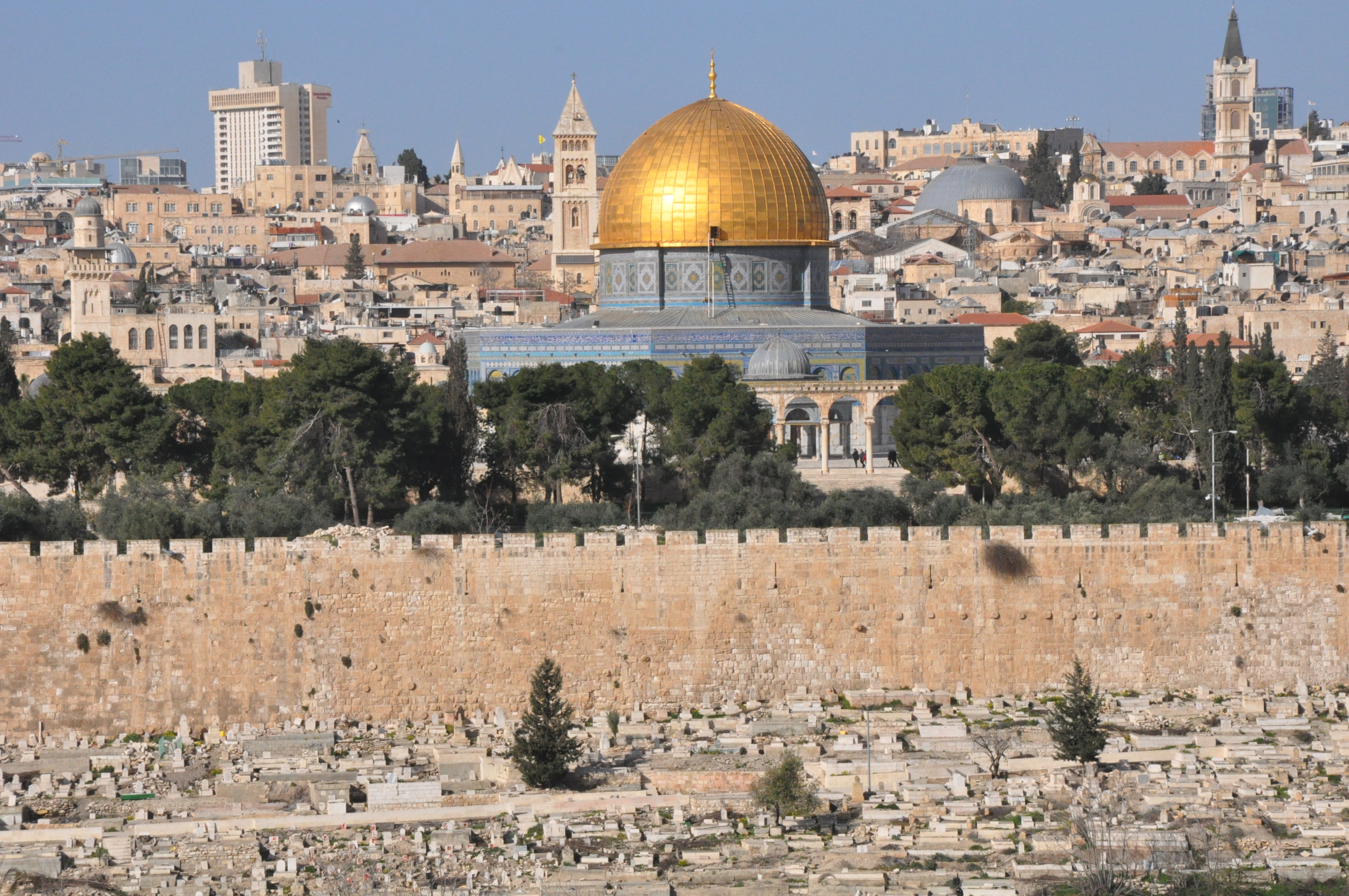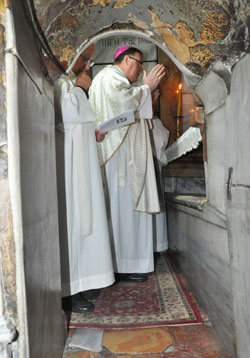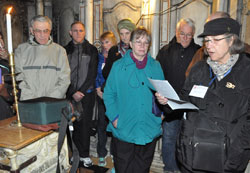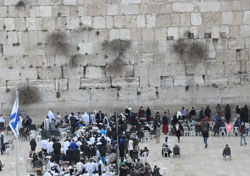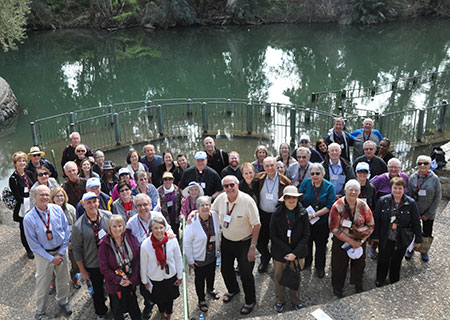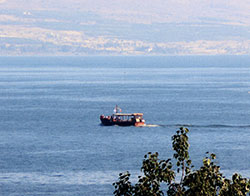By Natalie Hoefer
MT. TABOR, NAZARETH and CANA—It was in Nazareth that true God also became true man through Mary’s “yes” to the angel Gabriel. In Cana, Jesus—known only to the world as true man up to that point—performed his first miracle, displaying his heavenly power. Later in his ministry, Christ revealed himself to Peter, James and John as being both true God and true man through the transfiguration on Mt. Tabor.
The pilgrims today traced this connection in their visit to each of these holy sites.
(See a photo gallery from their day)
They started their day at Mt. Tabor, the geographical site of the transfiguration, although the precise spot is not known.
The church at the top of the mountain is an architectural representation of the three tents that Peter proposed to build on the site of the transfiguration, “one for [Christ], one for Moses and one for Elijah (Mt. 17:1-9).”
“Every year, people come on August 6 [the Feast of the Transfiguration] to watch the miracle occur,” said Tony Azraq, an Palestinian Catholic and archaeologist serving as tour guide for the pilgrimage.
The “miracle” is how on that day alone, between 1-2 p.m, the sun streaming through a window happens to rest upon and illuminate the gold-background of the painting of the transfiguration above the altar in the church.
“[The architect Antonio] Barluzzi said he did not design the church to do that, that it was not an intentional thing,” Azrag said.
The pilgrims headed about four miles away to the town of Nazareth where Archbishop Joseph W. Tobin and Father Joseph Newton concelebrated Mass in the church of their namesake—St. Joseph Church. Father Bob Mazolla also concelebrated. The church is built over the site believed to have been St. Joseph’s carpentry shop.
During his homily, the archbishop commented on some images of Jesus’ foster father in art.
“In Renaissance paintings, when St. Joseph is depicted as an old man, sitting off to the side, asleep,” he said. “I realized they were showing Joseph dreaming, like we heard in the Gospel today (Mt. 2:13-15, 19-23).
“For Joseph, it was a symbol of his openness and his trust in God,” the archbishop said. “He wasn’t sure what the plan was, but he trusted that God was leading him.
“Perhaps if we have particular cares, we can think of Joseph and open ourselves as best we can, trusting that there is a plan that is God’s plan, and that it’s good.”
The Blessed Mother, too, had such trust. In a grotto at the bottom of the Basilica of the Annunciation next to St. Joseph’s Church lies the room where Mary said “yes” to God’s plan for her, as revealed by the angel Gabriel.
“Our predecessors of faith would certainly not have forgotten the home where Mary lived,” said James Dubach of St. Mary Parish in Indianapolis. “We can be confident that that’s the same home, not just on faith but by the fact of the [early Christian-era] mosaics discovered by it [showing it to be a place of worship].”
Domoni Rouse of St. Rita Parish in Indianapolis was also struck by the site.
“I was just grabbed,” she said. “One of the main thoughts I had was, ‘I thank you Lord because you gave us Jesus, and you gave us the Blessed Mother.’ That feeling was inside me pouring out in gratitude: thank you, thank you, thank you, thank you.”
Azraq provided cultural insight into Scripture about the Annunciation.
“The Bible says that Mary was afraid [when she saw the angel],” he said. “Why was she afraid? Forget about angel wings.”
He explained that rooms such as that held to be the site of the Annunciation were stone rooms usually built below homes. One use for the rooms was as a place for women to go during times when they were considered ritually unclean.
“There was only one way in,” said Azraq. “Imagine you have a basement, and there’s only one set of stairs leading to it, and they lead from the kitchen. And you go up the stairs, leaving the basement empty, to get a drink from the fridge. You’re the only one there. And you go back downstairs, and you see a man standing down there, and he says, ‘Hi!’ As a woman alone in that room, you would be terrified!”
Azrag also pointed out a courtyard next to the basilica where Muslims were protesting for the right to build a mosque. He noted that the population of Nazareth is now 90 percent Muslim. Indeed, during the noon Mass celebrated by Archbishop Tobin, Muslim prayers sounded over speakers mounted near the basilica.
“It made me realize the need for us to support Christians in the Middle East,” Rouse said. “I’d hear about it back home, but hearing what Tony said and hearing those [Muslim] prayers made that so real for me.”
According to Azraq, the Muslim population in Cana, the next stop on the pilgrimage about four miles away, is now 80 percent.
There was no audible reminder of that fact in Cana, however, and the pilgrims enjoyed a visit to the site believed to be the location of the place where Jesus performed his first miracle—turning water into wine at a wedding feast. Again, archaeological findings, particularly demolished structures from the fourth century, point to the possibility of the site being that of the miracle.
In a side chapel of the church constructed over the site, several couples on the pilgrimage renewed their wedding vows.
“I asked Ron this morning if he was going to wear his maroon tux and pink ruffled shirt today,” said Ron’s wife, Joni Greulich.
Joking aside, Ron said he found the service to be “really special.”
“It was so nice to renew our vows with so many others who were renewing their vows, with the archbishop [presiding],” he said. He and Joni have been married for 37 years, have three children and six grandchildren. The couple are members of St. Simon the Apostle Parish in Indianapolis.
During his homily earlier at St. Joseph Church in Nazareth, the archbishop quoted from a book he read on “how to make love stay.”
“First, it’s never too late to have a happy childhood,” the archbishop said, paraphrasing from the book. “And second, it’s a mystery. Once you think you know everything about the other person … your love will die because the mystery is gone.
“It’s an insight into God and love, because the only thing that we can say about love and God is that God is love. When we love authentically, we’re touching that mystery.
“Maybe that pulls it all together for us in these days [on the pilgrimage],” Archbishop Tobin said in closing. “What we’re doing is glimpsing the mystery of God’s love for us. If we have the heart of little children, we’re greatly fascinated by the mystery: that God’s love for us is so great that he sent his only Son. And in this little town that was forgotten in the backwaters of Galilee, the Word became flesh and dwelt among us.”
See a photo gallery from Day Five of the pilgrimage
